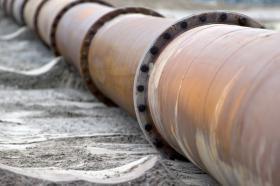Page 5
EPIB Trail
Volume 7, Issue 4
Lobbying for Disaster: The Keystone XL Pipeline Debate in American Politics By Alexander Toke Stretching 1,179 miles from the tar sands of Alberta, Canada, to the Gulf Coast of Texas, the Keystone XL pipeline has emerged not only as a major point of contention between members of Congress, but also a hotbed environmental issue that has gripped national consciousness. The Keystone XL is built to carry around 830,000 barrels of tar sands oil per day and bares a particularly dirty variety of oil; the refining of which produces 17 percent more emissions than normal crude. There are proponents and opponents of its construction; the relationship between energy development and the environment being the primary distinction between the two sides. On one hand, supporters of its construction claim that it will produce thousands of jobs involved in both its construction and maintenance, but also in the states through which it passes. Opponents of the project cite the multitude of dangers associated with the transportation of oil, especially oil as dirty as tar sands, as well as the impact that increased oil production will have on American greenhouse gas emissions contributing to Climate Change. With the project having passed both the House of Representatives and the Senate, the tension is palpable as both sides wait to see where the President’s pen might fall. This particular pipeline entered the national stage during the summer of 2011, when James Hansen, who was then the director of NASA’s Goddard Institute for Space Studies, raised concerns about the project, which was then still under debate, albeit subdued debate. Hansen published an article titled “Silence is Deadly,” in which he states that “governments are acting as if they are oblivious to the fact that there is a limit on how much fossil fuel carbon we can put into the air”; an attitude shared by many in the environmental movement and the scientific community. He concluded that the pipeline was not in the national interest, because it contributes to Climate Change, which will result in largely adverse effects on the American people. Through the intervening years, thousands of protests around the country have sparked a firestorm of debate over Keystone XL, with the most notable being the journey of hundreds of First Nation activists from Native American tribes around the United States and Canada. Dubbed “the Cowboy Indian Alliance” among others, these groups have come to be emblematic of the fight against the pipeline, which many First Nations peoples have called “the black snake”. Now, four years later, the pipeline has been approved by both the House and Senate, dominated as they are by Republicans who favor the project at the expense of the environment, and is awaiting an expected veto from lame-duck President Barack Obama. President Obama has stipulated in past months that Climate Change and the environment will be centerpieces of the final years of his administration, and many in the environmental movement are hoping to see their first major victory of this century on Capitol Hill. The project requires presidential approval as it crosses the border of the United States from a foreign entity. With a recent report from the Environmental Protection Agency citing that the pipeline would both contribute to harmful emissions that cause Climate Change via the tar sands pumped through it, as well as potentially damage water infrastructure and contaminate the local environment through which it passed. While proponents of both outcomes wait with bated breath for the President’s veto or approval, President Obama’s words regarding his commitment to combating Climate Change come to mind: “failure to do so would betray our children and future generations.” With the effects of Climate Change becoming more apparent and seemingly-inevitable day by day, evaluating the long-term costs of projects such as the Keystone XL pipeline are essential, because in a society obsessed with short-term profits, the global environment and the future of humanity cannot afford to be up for sale. “IEN Response to EPA Comments on KXL”.The Indigenous Environmental Network, 2015.http://www.ienearth.org/ien-response-to-epa-comments-on-kxl/. (Accessed February 10, 2015) Hansen, James. “Silence is Deadly”. Columbia University, 2011.http://www.columbia.edu/~jeh1/mailings/2011/20110603_SilenceIsDeadly.pdf. (Accessed February 10, 2015). Khan, Naureen. “Cowboys and Indians Ride Into U.S. Capital to Protest Keystone Pipeline”. Al Jazeera America, 2014.http://america.aljazeera.com/ articles/2014/4/22/keystone-xl-protestcowboysindiansranchers.html. (Accessed February 10, 2015). Khan, Naureen. “How Environmental Activists Turned a Pipeline Into Climate Movement”. Al Jazeera America, 2015.http://america.aljazeera.com/ articles/2015/2/9/how-climate-activists-turned-a-pipeline-into-a-green-movement.html. (Accessed February 10, 2015). Khan, Naureen.“In Keystone vote, Senate Dems Weigh Short-term Gain, Long-term Effects”.Al Jazeera America, 2014.http://america.aljazeera.com/ articles/2014/11/18/in-reversal-democraticsenatemaygreenlightkeystonepipeline.html. (Accessed February 10, 2015). Lizza, Ryan. “The President and the Pipeline”.The New Yorker, 2013.http://www.newyorker.com/magazine/2013/09/16/the-president-and-the-pipeline.
Back to Index

















